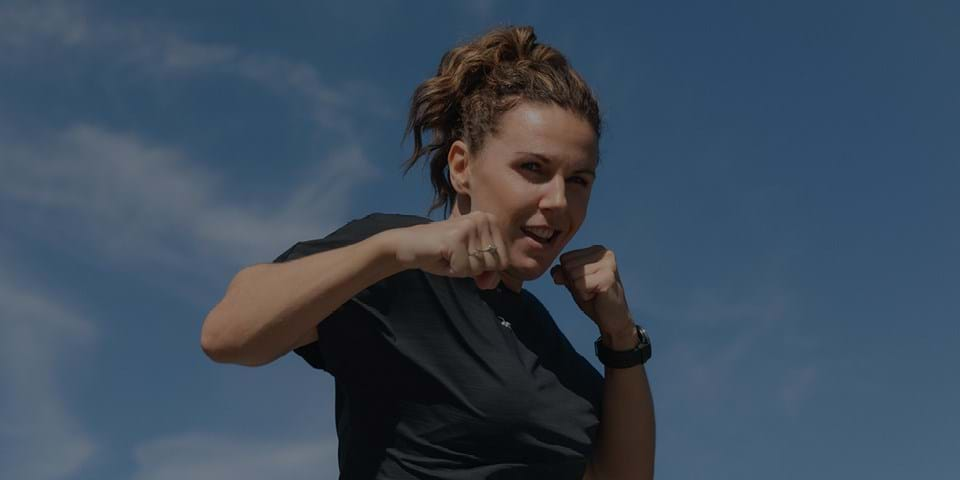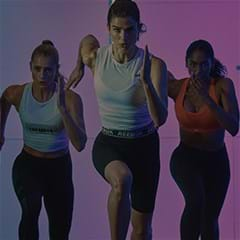WHAT ARE THE BEST GLUTE EXERCISES?
You won’t be surprised to know that many people have different opinions on this – so let’s turn to the research and see what this has to say.
A study published a few years ago looked at the most common therapeutic exercises to restore glute function and rated them according to the amount of electric activity they generated.
First let’s start with gluteus maximus– the big chunky butt muscle. Here’s what they found in order of most activation first:
THE TOP WAYS TO WORK YOUR GLUTEUS MAXIMUS
Single leg squat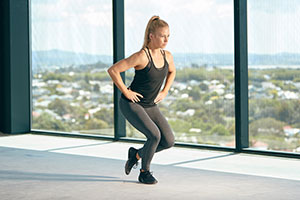
Start with your feet hip-width apart, chest lifted and abs engaged.
- Balance on one leg, bending one knee and lifting the foot behind you.
- Sit the hips down and back, pushing your front knee out over the mid-line of the foot.
- Keep the chest lifted and weight through the heel on the floor.
- Drive through the heel and squeeze the glute to rise.
Repeat 10-15 on each leg.
Single leg deadlift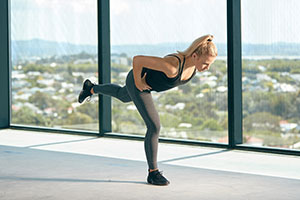
- Start with your feet hip-width apart, chest lifted and abs engaged.
- Lift one leg off the floor and soften the standing knee to activate the glutes.
- Keeping the chest lifted and back straight, hinge at the hips and lower your trunk until it’s almost parallel to the floor.
- Briefly pause at the bottom, then squeeze your glutes and push your hips forward to raise your torso back to the starting position.
Repeat 10-15 on each leg. For an extra challenge keep your foot off the ground when you return to standing.
Transverse lunge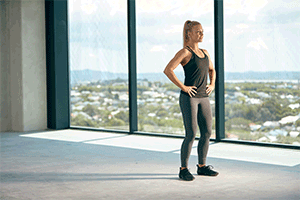
- Start with your hands on your hips and feet hip width apart.
- Lift your right leg and in a consecutive motion, rotate 180 degrees to your right.
- Land in a lunge position with your right knee and right hip at 90 degrees, then return to the starting position.
- Keep your trunk in an upright position throughout the movement and make sure you knee is tracking over your toes when you land in the lunge.
Repeat 10-15 on each leg.
Forward lunge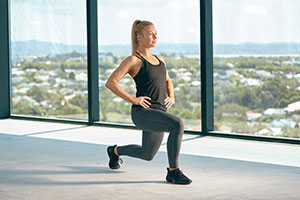
- Start with hands on hips, feet hip width apart and abs engaged.
- Take a long step forward and shift your weight forward so you land through your front heel.
- Bend your knees until your front thigh and back shin are parallel to the floor.
- Keep your back straight with your chest lifted and hips square, and ensure your front knee is tracking out over the mid-line of the foot.
- Press into your heel to drive back into the starting position.
Repeat 10-15 on each leg.
Side lunge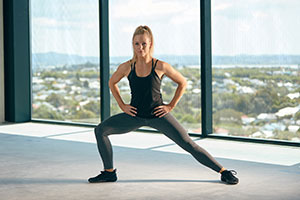
- Start with hands on hips, feet hip width apart and abs engaged.
- Take a long step forward and shift your weight forward so you land through your front heel.
- Bend your knees until your front thigh and back shin are parallel to the floor.
- Keep your back straight with your chest lifted and hips square, and ensure your front knee is tracking out over the mid-line of the foot.
- Press into your heel to drive back into the starting position.
Aim for 10-15 on each leg.
In summary it looks like squats, deadlifts and lunging come out on top. But there is one more glute max exercise that I need to highlight – and this one comes straight from the glute guy (Bret Contreras), a man who has made a living out of studying the glutes and how to train them. His number one exercise is hip thrusts.
According to Contreras hip thrusts improve the size, strength and appearance of the glutes. The effectiveness of the move is due to the fact that the glutes stay under constant tension throughout the whole movement, and the move is not compromised by back strength, which cannot be said of other popular glute building movements. And the bonus is that hip thrusts activate the hamstrings, quadriceps, and adductors very thoroughly as well.
Hip thrust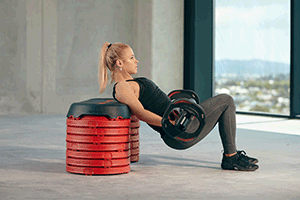
- Start with your shoulder blades against a bench and your arms spread across it for stability.
- Bend your knees and ensure your feet are flat on the floor.
- Brace your core, squeeze your glutes, lift your hips and hold for a couple of seconds at the top.
- Be careful not to hyperextend your lower back at the top.
- Lower down, keeping your abs engaged to move the body as one unit.
You can do this exercise without any weights, or intensify it by adding a weighted barbell across your hips. Repeat 10-15 times.
THE TOP WAYS TO WORK YOUR SIDE GLUTES
When it comes to working your side glutes these five moves are the way to go.
Side lying leg raise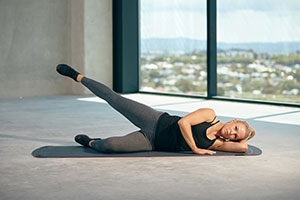
- Lie on one side, resting your head on your lower arm and with your upper hand on the floor for support.
- Brace your abs and bring your bottom knee slightly forward, resting the top leg on top of the leg on the ground.
- Lift the upper leg to the ceiling, keeping your hips stacked. Pause, then lower the leg.
Repeat 10-15 times then change sides.
Single leg squat 
- Start with your feet hip-width apart, chest lifted and abs engaged.
- Balance on one leg, bending one knee and lifting the foot behind you.
- Sit the hips down and back, pushing your front knee out over the mid-line of the foot.
- Keep the chest lifted and weight through the heel on the floor.
- Drive through the heel and squeeze the glute to rise.
Repeat 10-15 on each leg.
Lateral band walk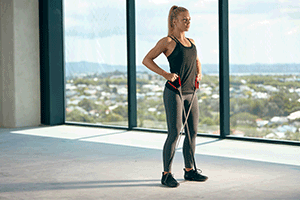
- Place both feet inside your resistance band, starting hip-width apart, and cross the handles at your hips.
- Brace the abs and lift the chest.
- Take a step to the right, bending the knees and pushing the hips back and down to a half-squat.
- Take 15 steps to the right, then repeat to the left.
Single leg deadlift
- Start with your feet hip-width apart, chest lifted and abs engaged.
- Lift one leg off the floor and soften the standing knee to activate the glutes.
- Keeping the chest lifted and back straight, hinge at the hips and lower your trunk until it’s almost parallel to the floor.
- Briefly pause at the bottom, then squeeze your glutes and push your hips forward to raise your torso back to the starting position.
Repeat 10-15 on each leg. For an extra challenge keep your foot off the ground when you return to standing.
Sideways hops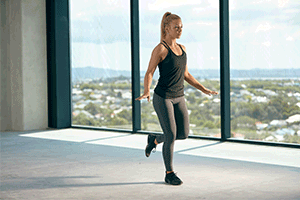
- Start with your feet hip-width apart, chest lifted and abs engaged.
- Balance on one leg, bending one knee and lifting the foot behind you.
- Jump to the right into a half squat, bending the knees and pushing the hips back and down. Repeat to the left.
Repeat 10-15 on each leg.
SO, WHAT GLUTE EXERCISES ARE A WASTE OF TIME?
Interestingly – the clam which is prescribed by loads of physical therapists for restoring side glute function came LAST in the study. As a physio, I apologize to all those people who I prescribed clams to over the years – I should have known – clams have terrible glutes too!
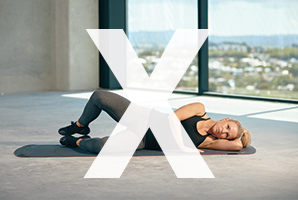
WHY DO YOU ACTUALLY NEED TO BOTHER WORKING YOUR BUTT?
Let’s face it – a lot of us are fascinated by the butt – myself included (for purely anatomical reasons of course). It’s likely that our obsession with the butt began when we became bipedal (primates have terrible glutes). Back then, spotting a potential partner with great glutes was probably a smart move, as it indicated they would be able to walk around looking for food for long periods and potentially run down an antelope.
In those days we didn’t need butt exercises because we were active.
Today however – due to long periods of inactivity and slouching when we do get the chance to stand up – our glutes have the chance to go on holiday. The consequence of this is far more dire than just your jeans not staying up. Your glutes help to hold your pelvis together, so when they go AWOL you can develop a pelvic instability – meaning joints in the lower back and pelvis don’t stay together when you walk and run. This can be very painful, so it is best avoided.
The number one way to steer clear of painful pelvic instability is to strengthen your glutes with targeted exercise. So, train hard, get some glutes and prepare for your pelvis to thank you.
Bryce Hastings is a leading New Zealand physiotherapist and fitness expert. As Les Mills Head of Research he leads research into the most effective approaches to exercise and plays a pivotal role in structuring all LES MILLS™ workouts. Bryce’s passion for effective exercise is born from spending 30 years in physiotherapy, where he saw “people getting their lives wrong” every day and felt like he was acting as an ambulance at the bottom of the cliff. By working in fitness he gets to be the fence at the top.




